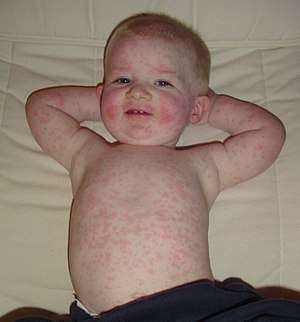Fifth disease
Erythema infectiosum or fifth disease is one of several possible manifestations of infection by parvovirus B19.[3]
| Erythema infectiosum | |
|---|---|
| Other names | Slapped cheek syndrome, slapcheek, slap face, slapped face[1][2] |
 | |
| 16-month-old with erythema infectiosum | |
| Specialty | Infectious disease |
The name "fifth disease" comes from its place on the standard list of rash-causing childhood diseases, which also includes measles (first), scarlet fever (second), rubella (third), Dukes' disease (fourth, but is no longer widely accepted as distinct), and roseola (sixth).
Signs and symptoms
Fifth disease starts with a low-grade fever, headache, rash, and cold-like symptoms, such as a runny or stuffy nose. These symptoms pass, then a few days later, the rash appears. The bright red rash most commonly appears in the face, particularly the cheeks. This is a defining symptom of the infection in children (hence the name "slapped cheek disease"). Occasionally, the rash will extend over the bridge of the nose or around the mouth. In addition to red cheeks, children often develop a red, lacy rash on the rest of the body, with the upper arms, torso, and legs being the most common locations. The rash typically lasts a few days and may itch; some cases have been known to last for several weeks. Patients are usually no longer infectious once the rash has appeared.[1][2]
Teenagers and adults may present with a self-limited arthritis. It manifests in painful swelling of the joints that feels similar to arthritis. Older children and adults with fifth disease may have difficulty in walking and in bending joints such as wrists, knees, ankles, fingers, and shoulders.[1][2]
The disease is usually mild,[4] but in certain risk groups, it can have serious consequences:
- In pregnant women, infection in the first trimester has been linked to hydrops fetalis, causing spontaneous miscarriage.
- In people with sickle-cell disease or other forms of chronic hemolytic anemia such as hereditary spherocytosis, infection can precipitate an aplastic crisis.[1][2]
- Those who are immunocompromised (HIV/AIDS, chemotherapy) may be at risk for complications if exposed.[5]
Transmission
Fifth disease is transmitted primarily by respiratory secretions (saliva, mucus, etc.), but can also be spread by contact with infected blood. The incubation period (the time between the initial infection and the onset of symptoms) is usually between 4 and 21 days. Individuals with fifth disease are most infectious before the onset of symptoms. Typically, school children, day-care workers, teachers, and parents are most likely to be exposed to the virus. When symptoms are evident, the risk of transmission is small; therefore, symptomatic individuals do not need to be isolated.[1][2]
Treatment
Treatment is supportive, as the infection is frequently self-limiting. Antipyretics (i.e., fever reducers) are commonly used. The rash usually does not itch, but can be mildly painful. No specific therapy is recommended.
Epidemiology
Any age may be affected, although it is most common in children aged 5 to 15 years.[6] By the time adulthood is reached, about half the population will have become immune following infection at some time in their past.[1][2] Outbreaks can arise especially in nursery schools, preschools, and elementary schools. Infection is an occupational risk for school and day-care personnel.[7] No vaccine is available for human parvovirus B19,[2] though attempts have been made to develop one.[8]
History
It, or a disease presenting similarly,[9] was first described by Robert Willan in 1799 as "rubeola, sine catarrho". It was better defined by Anton Tschamer in 1889 as a rubella variant (Ortliche Rotheln), identified as a distinct condition in 1896 by Theodor Escherich, and given the name "erythema infectiosum" in 1899.[10] The term "Fifth disease" was coined in 1905 by the Russian-French physician Léon Cheinisse (1871-1924), who proposed a numbered classification of the six most common childhood exanthems.[11][9][12][13][14] The virus was first described in 1957 at the University of Pennsylvania by Werner, Brachman et al.[15]
See also
References
- Sabella C, Goldfarb J (October 1999). "Parvovirus B19 infections". Am Fam Physician. 60 (5): 1455–60. PMID 10524489. Retrieved 2009-11-06.
- Servey JT, Reamy BV, Hodge J (February 2007). "Clinical presentations of parvovirus B19 infection". Am Fam Physician. 75 (3): 373–6. PMID 17304869. Retrieved 2009-11-06.
- Weir E (March 2005). "Parvovirus B19 infection: fifth disease and more". CMAJ. 172 (6): 743. doi:10.1503/cmaj.045293. PMC 552884. PMID 15767606.
- Mankuta D, Bar-Oz B, Koren G (March 1999). "Erythema infectiosum (fifth disease) and pregnancy". Can Fam Physician. 45: 603–5. PMC 2328398. PMID 10099795.
- Yoto, Y., et al., (2003). "Retrospective study on the influence of human parvovirus B19 infection among children with malignant diseases". Acta Haematol pg.8–12, PMID 8237278
- Kwon, Kenneth T (March 19, 2009). "Pediatrics, Fifth Disease or Erythema Infectiosum". eMedicine. Retrieved November 7, 2009.
- Gillespie, S. M.; Cartter, M. L.; Asch, S; Rokos, J. B.; Gary, G. W.; Tsou, C. J.; Hall, D. B.; Anderson, L. J.; Hurwitz, E. S. (1990). "Occupational risk of human parvovirus B19 infection for school and day-care personnel during an outbreak of erythema infectiosum". JAMA. 263 (15): 2061–5. doi:10.1001/jama.1990.03440150069028. PMID 2157074.
- Ballou WR, Reed JL, Noble W, Young NS, Koenig S (2003). "Safety and immunogenicity of a recombinant parvovirus B19 vaccine formulated with MF59C.1". J Infect Dis. 187 (4): 675–8. doi:10.1086/368382. PMID 12599085.
- David M. Morens. Fifth Disease: Still Hazy After All These Years
- Altman, Lawrence K (November 30, 1982). "THE DOCTOR'S WORLD". The New York Times. Retrieved November 7, 2009.
- Robert R. Briney. Primary Cutaneous Actinomycosis
- Dictionary of Virology
- St. Louis Courier of Medicine (1906)
- Principles and Practice of Clinical Virology
- Werner, Georges H.; Brachman, Philip S.; Ketler, Albert; Scully, John; Rake, Geoffrey (1957). "A new viral agent associated with Erythema Infectiosum". Viruses in Search of Disease. Annals of the New York Academy of Sciences. 67. pp. 338–345. doi:10.1111/j.1749-6632.1957.tb46058.x. PMID 13411972.
External links
| Classification | |
|---|---|
| External resources |